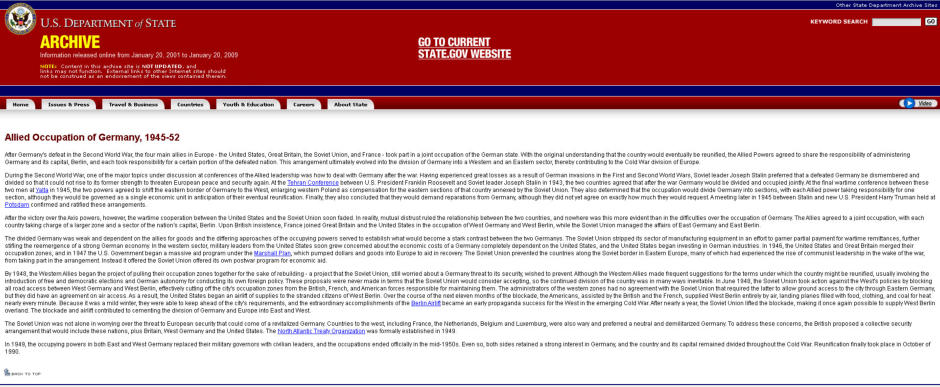
The Alternative History of Ditchburn
by Karl Dawson, Arthur Philips and Chris Freeman
Don’t always believe what you read in the newspapers
Don’t
always
believe
what
you
read
in
the
newspapers…
Its
as
true
today
as
it
was
back
in
the
1946,
today
we
read
the
goings
on
about
Katie
Price
and
the
also
latest
gossip
regarding
the
Kardashian’s
etc
….
we
all
know
that
most
of
these
stories
are
generated
by
publicists
and
agents
for
these
people
to
drive
the
hype
and
spin
that
are
needed
to
promote
these
celebrities
and
their
products,
unfortunately
in
100
years
time
when
someone
like
me
is
researching
about
the
history
of
Kim
Kardashian,
we
only
have
what
was
written in news papers and promotional videos etc. to base this history on, and as we know today its not always totally true.
The
same
can
be
said
for
me
now
researching
the
early
the
early
days
of
the
Music
Maker
…
I
am
neither
a
historian
or
a
Jukebox
collector,
I
am
just
passionate
about
keeping
the
history
of
Ditchburn
alive.
When
i
started
this
project
there
was
very
little
information
available
and
what
i
did
find
scattered
over
many
websites
in
some
cases
contradicted
itself,
i
am
trying
to
keep
the
history
on
this
website
true
and
factually
correct
as
i
possibly
can,
When
i
started
this
site
i
was
believing
all
the
newspaper
cuttings
that
i
collected
from
1946
onwards
…
In
this
last
few
months
i
have
spoken
with
people
that
were
actually
working
at
Ditchburn
(
Arthur
Phillips
and
Chris
Freeman
)
and
their
stories
regarding
the
early
days
of
Ditchburn
are
amazingly
similar,
Chris
Freeman
worked
for
Ditchburn
until
1963
and
Arthur
Philips
worked
from
1963
till
the
company
closed
in
1973.
I
had
some
very
nice
emails
from
Jukebox
Authority,
Mr
Tony
Holmes,
who
said
to
me
that
he
didn’t
believe
that
my
website
was
completely
factual,
“but
time
will
tell”
and
those
wise
words
are
so
true,
the
more
i
dig
for
information
and
talk
to
people
the
more
i
find
that
the
original
articles
may
not
be
as
factual
as
we
thought they were.
Lets
start
at
the
beginning
…
with
Jack
Hylton,
Jack
was
an
impresario,
he
had
his
fingers
in
many
pies
and
was
always
looking
at
ways
of
promoting
himself,
and
the
jukebox
was
a
medium
that
the
public
would
hear
his
music
and
every
Hylton
record
that
was
sold
to
be
put
on
a
jukebox,
he
would
receive
a
slice
of
that
pie,
so
it
was
important
for
him
to
promote
the
Jack
Hylton
Music
Maker
in
a
very
positive
way,
also
Jack
Hylton
never
put
just
his
own
money
into
these
projects
he
used
investors
that
would
fund
his
ventures,
in
the
same
way
that
his
musicals
and
theatre
production’s
used
investors
that
were
hoping
to
make
a
handsome
profit
if
the
show
was a success.
Lets
look
at
the
original
article
back
from
1946
that
i
and
I’m
sure
many
others
took
as
factual
from
the
early
days,
but
in
reality
may
have just been promotional propaganda to get funding and to please investors.
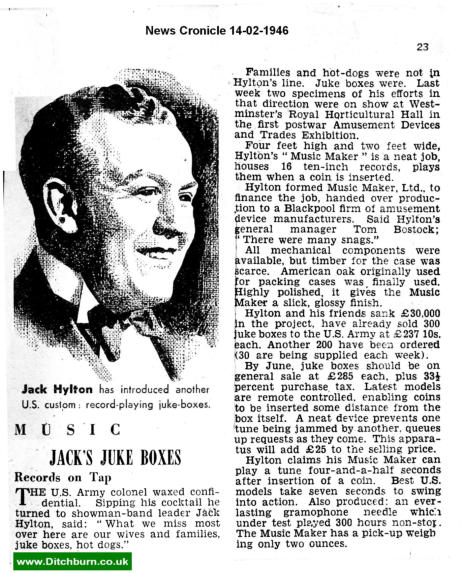
The
above
all
seems
quite
feasible
and
i
believed
it
was
probably
true,
that
was
until
i
spoke
with
ex-Ditchburn
employees,
Arthur
Philips
and
Chris
Freeman,
both
of
them
(note:
they
did
not
know
each
other
)
said
that
were
told
by
people
that
had
worked
at
Ditchburn
from
the
very
beginning,
that
in
1945
Hylton
thought
that
it
would
be
great
to
get
into
the
Jukebox
market
but
unfortunately
by
the
time
Hylton
had
the
Jukebox
ready
for
production
the
war
was
over…
in
1946
in
the
UK
most
of
the
US
troops
had
either
gone
home
or
moved
to
the
bases
set
up
in
the
now
occupied
Germany
and
there
was
no
demand
for
Jack’s
Music
Maker
Jukebox
here
in
the
UK,
although
between
1945
and 1952 there were over 2 million US troops stationed in Germany.
In
a
speech
give
by
Mr
Ditchburn
in
the
USA
in
1957
he
stated
that
Jack
Hylton
and
Hawtin’s
Made
500
Jukeboxes
and
they
were
all
shipped
to
occupied
Germany
to
by
used
by
the
US
forces
stationed
there
…
based
on
these
facts
and that there were a lot of US bases being set up in newly occupied Germany it looks like this was the case.
We
have
mentioned
in
the
main
History
section
that
the
Wurlitzer
Mechanisms
were
flown
into
the
UK
by
the
US
air
force
in
crates
marked
as
essential
war
supplies,
this
part
seems
to
be
true
but
the
reality
was
there
was
not
the
300
to
500
mechanisms
that
are
stated
in
the
above
publicity
article,
in
reality
there
were
only
approximately
30
mechanisms
shipped
by
the
US
air
force
to
the
UK,
These
mechanisms
were
a
“Wurlitzer
16
play
Simplex
Mechanism”
that
was
not
being
made
any
more
in
the
USA,
and
they
were
based
around
the
16
play
Simplex
Mechanism that was last manufactured in the USA in 1939.
It
is
understood
that
there
was
an
agreement
with
Hawtin’s
and
Wurlitzer
to
produce
the
16
play
mechanisms
here
in
the
UK,
all
the
early
Hawtin’s
Jukeboxes
i
have
seen
have
non
Wurlitzer
casting
numbers
on
them.
so
the
Parts
were
all produced and assembled here in the UK, I have not found any machines that contain actual Wurlitzer parts.
The
Serial
Numbers
on
the
Mk1s
and
MK2s
mechanisms
have
a
prefix
of
H1xxx
and
H2xxx
the
H
is
for
Hawtin’s,
and
we
have
record
of
serial
numbers
in
the
range
of
H1574
to
H2594
so
it
looks
that
there
was
over
1000
machines
produced, although we don’t know if all the serial numbers were allocated to machines.
So
the
Big
Question
for
us
here
at
the
Ditchburn
Project
is
….
if
500
machines
were
sent
to
Germany
in
1946
why
have none re-surfaced in Germany now ? You would expect 10 to 20 at least to survive, but there is nothing…
I
believe
the
reasons
for
this
are
the
following
(
although
this
is
yet
to
be
confirmed
)
When
Hawtin’s
sold
the
Jukebox
business
to
Mr
Ditchburn
in
1947
it
included
the
machines
that
were
on
site
at
US
air
force
bases
in
Germany,
in
Mr
Ditchburns
1957
speech
he
states
…
Hawtin’s
made
nearly
500
Machines
and
shipped
them
to
occupied
Germany
then the business doubled and we took it over as a prize speculation.
So
these
machines
in
Germany
would
have
needed
to
be
repaired,
serviced
and
records
replaced
on
a
regular
basis,
and
this
was
where
we
believe
that
Mr
Ditchburn
saw
the
future…
when
he
took
over
the
business
he
was
looking
after
the
Jukeboxes
on
the
various
US
bases
and
when
they
were
no
longer
required
or
the
base
closed
he
would
bring
them
back
to
the
UK
and
site
them
here
in
the
UK
…
so
eventually
all
the
machines
in
Germany
came
back
to
the UK as the bases closed, and were relocated in the cafes and snack bars.
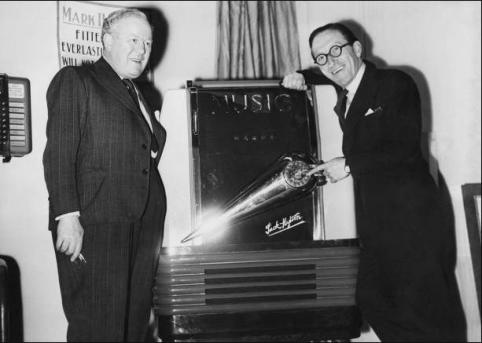
This
prototype
Jack
Hylton
MK2
Jukebox
with
the
Jack
Hylton
Logo
(above)
is
believed
to
be
the
only
one
ever
made
and
never
actually
went
into
production,
there
are
many
surviving
Ditchburn
MK2
units
currently
owned
by
collectors
but
no
known
MK2
Hylton
machines
have
been
seen
or
have
surfaced
on
the
collectors
market.
so
it
is
assumed
that
this
prototype
is
long
lost
or
destroyed.
I
spoke
with
Chris
Freeman
about
the
wall
box,
because
i
have
never
seen
a
Ditchburn
MK1
MK2
MK2R
with
remote
functionality,
all
the
ones
that
are
surviving
have
no
facility
for
remote
connection
or
selection
using
a
wall
box.
But
Chris
said
that
they
did
exist
in
a
simple
hideaway
format,
and
he
remembered
servicing
these
in
the
early
days.
these
were
the
MK2
H16/45
a
16
selection
mechanism
that
had
electromagnetic
coils
to
activate
the
selection
process
instead
of
the
push
buttons,
there
were
very
few
of
these
made,
and
they
basically
consisted
of
the
standard
16
selection
MK2
mech
in
a
plain
plywood
box
with
no
coin
slot
etc.
so
there
were
certainly
were
more
wall boxes made during the early Ditchburn years.
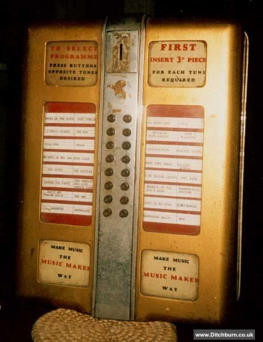
Photo Courtesy of Tony Holmes
Hylton, Hawtin’s, and Ditchburn
Again
from
conversations
with
Arthur
and
Chris
it
seems
that
Mr
Ditchburn
did
not
have
any
direct
business
dealings
with
Jack
Hylton,
at
the
time
Mr
Ditchburn
was
looking
to
set
up
a
company
to
manufacture
metal
partitions
and
windows,
but
he
could
not
do
this
openly
as
his
agreement
on
his
departure
from
Rowe
Brothers
was
not
to
make
similar
products
for
at
least
3
years.
so
he was looking at other ventures and the Jukebox interested him,
This
would
later
lead
to
legal
issues
with
Jack
Hylton
as
Jack
had
registered
the
Music
Maker
name,
and
Mr
Ditchburn
had
carried on using the Music Maker name unknowingly as part of the Company he had bought from Hawtin’s.
GND”
(Mr
Ditchburn)
as
Arthur
told
me
“he
like
to
be
called”…
was
a
very
shrewd
business
man
and
one
of
his
habits
was
that
he
did
not
like
to
throw
anything
away,
this
became
very
apparent
through
the
years
…
one
of
the
advantages
that
GND
had
was
that
he
never
sold
Jukeboxes
only
operated
them,
collected
the
rent
replaced
the
records
etc.
He
felt
that
if
a
jukebox
mechanism
still
had
some
life
left
in
it
he
would
use
it,
this
was
seen
in
the
conversions
of
the
MK2
machines
to
the
MK2R
in
which
the
16
play
78s
MK2s
came
back
to
Lytham
and
were
converted
to
the
30
play
45rpm
MK2R
these
conversions
happened
around
1958
as
it
was
around
this
point
that
45rpm
7”
singles
had
made
an
appearance,
the
changeover
to
45s
took
quite
a
few
years
in
the
UK
as
most
homes
only
had
78rpm
record
players
and
people
in
the
UK
were
initially
reluctant
to
change
due
to
the
cost
of
the
new
players.
So
the
16
player
machines
were
returned
the
tops
were
cut
off
and
a
new
wind
shield
style
top
was
fitted,
most
people
believe
that
the
complete
top
was
made
from
fibreglass,
but
we
now
understand
it
was
only
the
initial
units
were
made
like
his,
(
these
had
no
side
windows
)
most
of
the
conversions
were
plywood
construction
with
a
fibreglass
sloping
lid.
the
original
16
player
mech
was
rebuilt
as
a
30
player
selection
with
Ditchburn
designed
parts
(Wurlitzer
never
made
a
30
player
mech
)
after
a
new
coat
of
paint
these
machines
looked
brand
new
and
were
then
put
back
into
business
on
sites
around
the
country.
most
customers
thought
they
had
got
a
brand
new
Jukebox
…
but
the
reality
was
it
was
just
a
refurbished
and
updated
machine
some
of
which
had
been
sent to Germany in 1946.

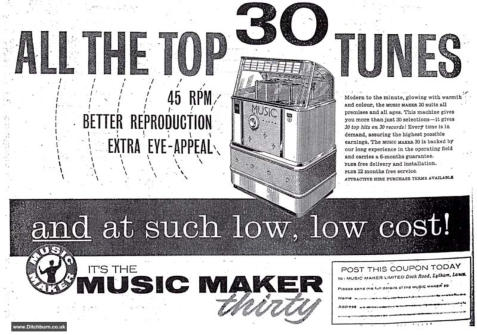
This
use
of
existing
equipment
trait
of
GND
was
also
very
apparent
later
during
the
Tonomat
years,
in
1957
Ditchburn
bought
150
or
more
of
the
Tonomat
200
selection
jukeboxes,
but
after
10
years
or
so
these
machines
started
being
returned
to
the
Dock
Road
factory
because
they
looked
out
of
date
and
not
modern
enough
to
compete
with
the
newer
Wurlitzer
Lyrics
that
Ditchburn
were
importing
from
Germany,
at
that
time
the
customers
wanted
the
modern
looking
machines,
so
again
GND
decided
that
these
old
Tonomat
machines
still
had
plenty
of
life
left
in
them,
so
he
asked
a
cabinet
company
to
put
forward
three
designs
to
update
the
cabinet
to
a
more
modern
Wurlitzer
Lyric
style,
finally
a
design
was
chosen
and
in
1968
Ditchburn
produced
the
new
Music
Maker
200
which
in
reality
contained
the
insides
of
the
1957
Tonomat
200,
again
most
of
the
customers
thought
they
were
getting
a
brand
new
machine
which
in
reality
was
a
new
cabinet
that
contained
the
workings
of
an old 1957 Tonomat 200 Jukebox.
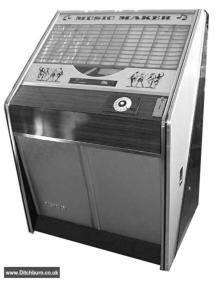
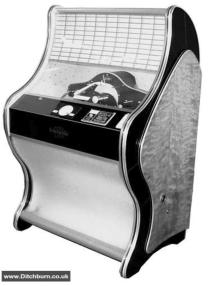

Ditchburn’s business model continued like this over the years including the vending side which used parts imported from the
USA and installed into UK manufactured enclosures.
The alternative History of Ditchburn will continue at a later date.
To Be Continued…..






